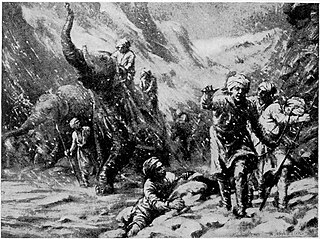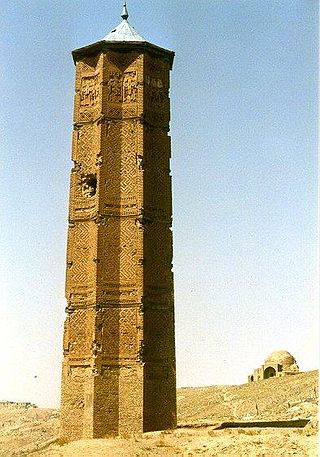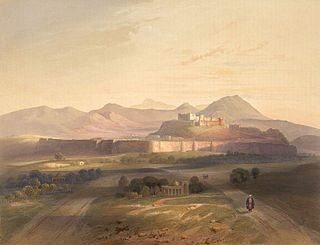
Ghazni, historically known as Ghaznain (غزنين) or Ghazna (غزنه), also transliterated as Ghuznee, and anciently known as Alexandria in Opiana, is a city in southeastern Afghanistan with a population of around 190,000 people. The city is strategically located along Highway 1, which has served as the main road between Kabul and Kandahar for thousands of years. Situated on a plateau at 2,219 metres (7,280 ft) above sea level, the city is 150 kilometres (93 mi) south of Kabul and is the capital of Ghazni Province. The name Ghazni drives from the Persian word "ganj", meaning ‘treasure’.

The Ghaznavid dynasty or the Ghaznavid Empire was a Persianate Muslim dynasty and empire of Turkic mamluk origin, ruling at its greatest extent, large parts of Iran, Khorasan, and the northwest Indian subcontinent from 977 to 1186. The dynasty was founded by Sabuktigin upon his succession to the rule of Ghazna after the death of his father-in-law, Alp Tigin, who was an ex-general of the Samanid Empire from Balkh.

Abu al-Qasim Mahmud ibn Sabuktigin, usually known as Mahmud of Ghazni or Mahmud Ghaznavi, was Sultan of the Ghaznavid Empire, ruling from 998 to 1030. During his reign and in medieval sources, he is usually known by his honorific Yamin al-Dawla. At the time of his death, his kingdom had been transformed into an extensive military empire, which extended from northwestern Iran proper to the Punjab in the Indian subcontinent, Khwarazm in Transoxiana, and Makran.

Jayapala was a ruler of the Hindu Shahi dynasty from 964 to 1001 CE. He ruled over the area which stretched from Laghman in the west, to Kashmir in the east and from Sirhind to Multan. He was the son of Hutpal and the father of Anandapala. Epithets from the Bari Kot inscriptions record his full title as "Parama Bhattaraka Maharajadhiraja Sri Jayapaladeva".

Nuh II was amir of the Samanids (976–997). He was the son and successor of Mansur I.

Abu Salih Mansur, better known as Mansur I (منصور) was amir of the Samanids from 961 to 976. The son of Nuh I, his reign was characterized by weak rule and perpetual financial troubles. Mansur was notably the first Samanid ruler to the use title of King of Kings (Shahanshah), most likely as a response to his rival, the Buyid ruler Adud al-Dawla, who likewise used the title. He is also known by the sobriquet Amīr-i Sadid.

Alp-Tegin, or Alptekin, was a Turkic slave commander of the Samanid Empire, who would later become the semi-independent governor of Ghazna from 962 until his death in 963.
The Al-i Muhtaj or Muhtajids was an Iranian or Iranicized Arab ruling family of the small principality of Chaghaniyan. They ruled during the 10th and early 11th centuries.

Chaghaniyan, known as al-Saghaniyan in Arabic sources, was a medieval region and principality located on the right bank of the Oxus River, to the south of Samarkand.
The Farighunids were an Iranian dynasty that ruled Guzgan in the late 9th, 10th and early 11th centuries. They were ultimately deposed by the ruler of the Ghaznavid Empire, Sultan Mahmud.
The Hindu Shahis also referred to as the Uḍi Śāhis were a dynasty established between 843 CE and 1026 CE. They endured multiple waves of conquests for nearly two centuries and its core territory was described as having contained the regions of Eastern Afghanistan and Gandhara, encompassing the area up to the Sutlej river in modern day Punjab, expanding into the Kangra Valley. The empire was founded by Kallar in c. 843 CE after overthrowing Lagaturman, the last Turk Shahi king.
The Battle of Peshawar was fought on 27 November 1001 between the Ghaznavid army of Mahmud of Ghazni and the Hindu Shahi army of Jayapala, near Peshawar. Jayapala was defeated and captured, and as a result of the humiliation of the defeat, he later immolated himself in a funeral pyre. This is the first of many major battles in the expansion of the Ghaznavid Empire into the Indian subcontinent by Mahmud.
Abu'l Haret Ahmad was the third Farighunid ruler of Guzgan from 982 to 1000. He was the son and successor of Abu'l Haret Muhammad.
Abu'l-Hasan Ali ibn Fadl ibn Ahmad Isfarayini, commonly known as Abu'l-Hasan Isfarayini, was a Persian vizier of the Ghaznavid sultan Mahmud of Ghazni from 998 to 1010.
Böritigin or Böri, also known as Pirai, was a Turkic officer, who served as the Samanid governor of Ghazna from 974/975 to 977.
Abu Ishaq Ibrahim, also known as Ishaq ibn Alp-Tegin, was a Turkic officer, who was the Samanid governor of Ghazna from September 963 to November 966. He was the son and successor of Alp-Tegin.
Abu Bakr Lawik was a ruler of Ghazna from the Lawik dynasty. He was most likely a vassal of the Samanid Empire. In 962, the Turkic slave commander Alp-Tegin captured Ghazna after besieging the Citadel of Ghazni for four months. However, a few years later, Lawik managed to re-capture the town from Abu Ishaq Ibrahim, the son and successor of Alp-Tegin. This was not to last long; Abu Ishaq Ibrahim shortly returned to the town with Samanid aid, and took control of the town once again. Abu Bakr Lawik is thereafter no longer mentioned; he died before 977, the year that Ghaznavid control was established in Ghazna.

Ghazni is a city in southeastern Afghanistan, which served as the capital of the Ghaznavid Empire from 977 to 1163.
Hasan b. SulaymanBughra Khan was an energetic ruler of western part of Karakhanid state, ruling nominally under Ali Arslan Khan, but de facto independent. He was the grandson of Satuk Bughra Khan through his second son Sulayman Khan. He inherited his father's appanages in the west sometime later before 990, becoming the founder of the Hasanid branch of the Karakhanid family.

The Lawīk dynasty was the last native dynasty which ruled Ghazni prior to the Ghaznavid conquest in the present-day Afghanistan. Lawiks were originally Hindus, but later became Muslims. They were closely related to the Hindu Shahis, and after 877, ruled under the Hindu Shahi suzerainty.













